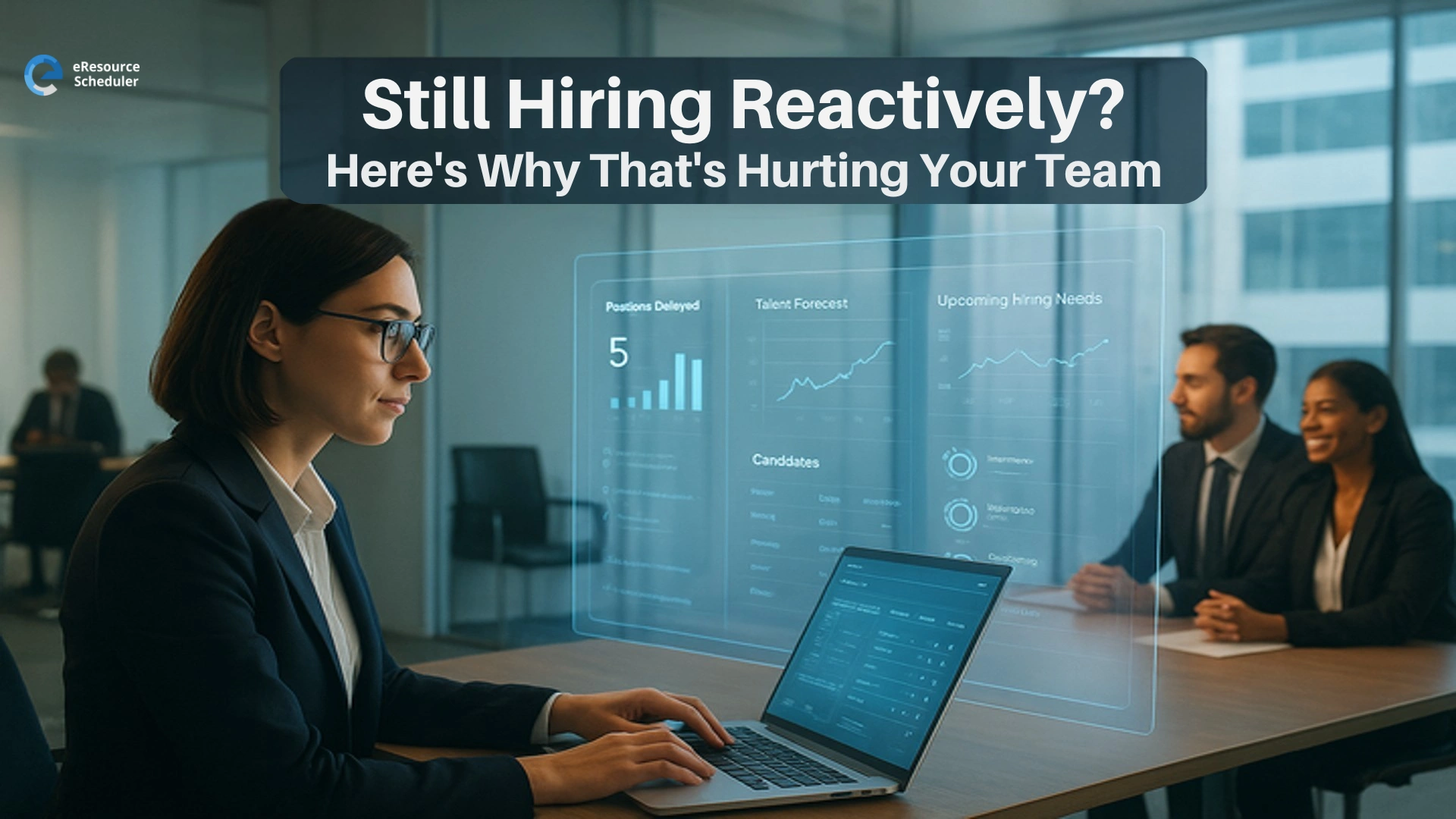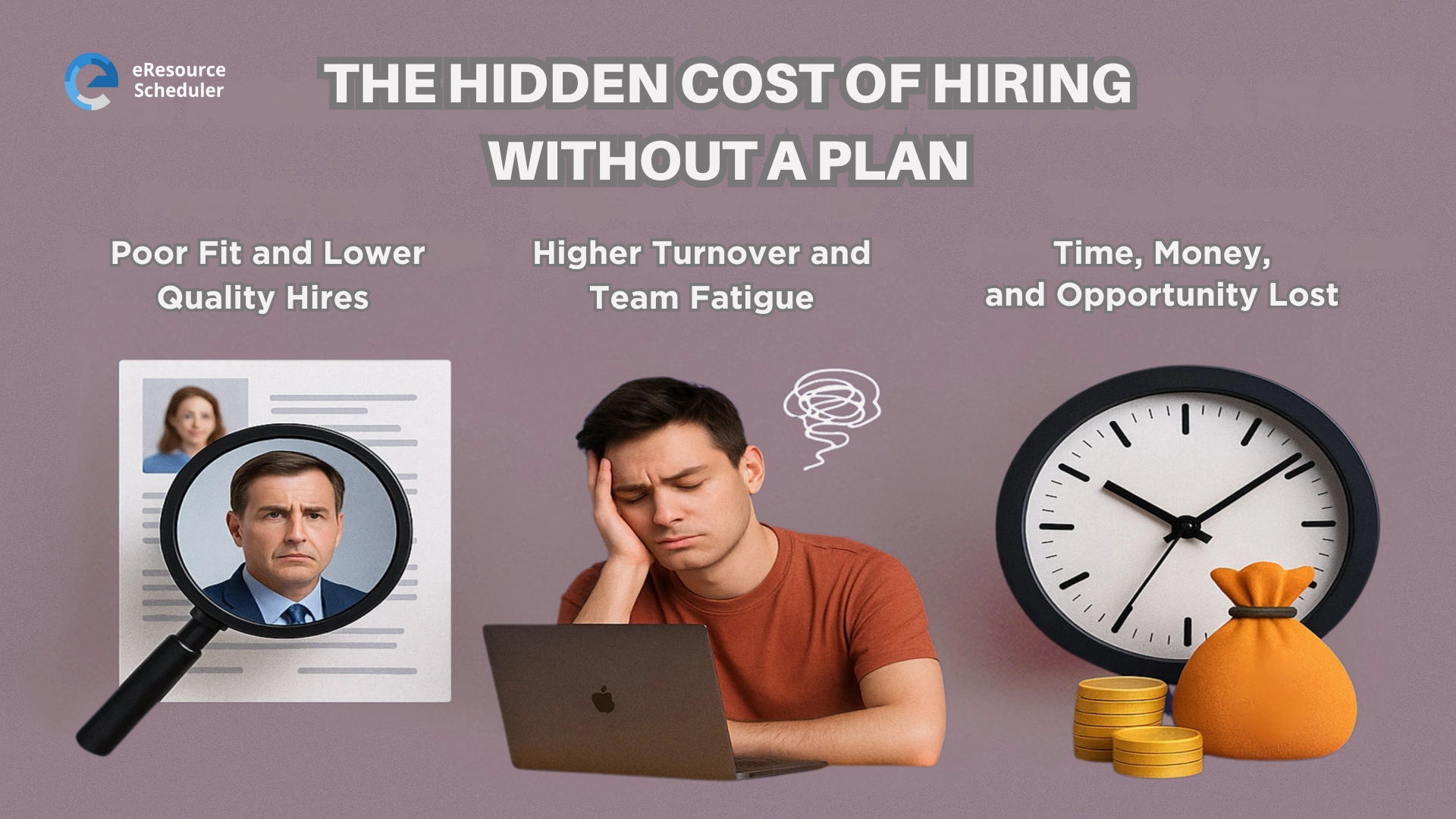
Every manager has faced it, a sudden resignation or an unexpected project launch that sparks a hiring scramble. Resumes pile up, interviews blur together, and someone is hired just to fill the gap. It feels like progress, but often leads to mismatched skills, burnout, and another vacancy soon after.
Reactive hiring might solve an immediate problem, but it creates long-term instability. In 2026, forward-thinking organizations are breaking this cycle by aligning proactive hiring with data-driven planning. When teams use resource scheduling to forecast workloads and predict upcoming needs, hiring becomes strategic rather than rushed.
This approach helps companies plan ahead, match skills to demand, and maintain balance even during high-pressure periods. The result? Teams that stay engaged, leaders who make confident staffing decisions, and an organization that grows with intention, not reaction.
Sometimes, reactive hiring hides in plain sight. Teams believe they are being productive when in reality, they are just putting out fires. The signs are easy to miss until patterns start to repeat.
If your hiring calendar feels like a never-ending cycle of urgent roles, that is a clear warning. Positions open up suddenly, recruitment begins under pressure, and projects slow down while everyone scrambles to adjust. This usually means there is no clear visibility into future workload or workforce capacity.
Another indicator is the team itself. When employees consistently stay late, skip breaks, or seem disengaged, it signals a resource imbalance. They are covering gaps that could have been prevented with better planning. In a recent Gallup survey, 77 percent of U.S. employees reported burnout directly linked to poor staffing levels. Burnout not only reduces productivity but also increases turnover, creating another hiring rush.
If job postings for the same skills keep reappearing every few months, it is a symptom of deeper planning issues. This happens when leaders fail to forecast what skills future projects will require. A more strategic approach, backed by talent forecasting and ongoing skills assessment, helps prevent repeated shortages and ensures the right people are in the right roles at the right time.
If managers spend more time reacting than preparing, the organization is stuck in a reactive loop. The best teams run on anticipation, not surprises. When planning becomes part of the culture, hiring stops being an emergency and starts being an advantage.

Hiring reactively might feel like the fastest way to solve a problem, but the hidden costs pile up quickly. When speed replaces strategy, the results often lead to mismatched hires, team fatigue, and lost opportunities.
When hiring decisions are made under pressure, the process naturally skips important steps. Cultural alignment, skill depth, and role clarity get overlooked. The wrong hire can affect an entire team’s performance, slowing down projects and raising frustration levels. Over time, the organization ends up paying more to replace and retrain than it would have spent on planning ahead.
Quick hires rarely stay long. Employees who join without proper onboarding or role clarity often feel disconnected and leave within months. Their exit restarts the hiring cycle and drains morale. Teams that constantly adjust to new members lose rhythm and energy, which directly affects productivity.
Every reactive hire diverts focus from meaningful work. Leaders spend hours interviewing, onboarding, and troubleshooting performance issues instead of driving innovation or client relationships. The financial loss is measurable, but the missed growth opportunities hurt even more.
Predictive and proactive hiring strategies prevent these losses by creating stability and clarity. Teams perform better when hiring supports long-term goals rather than patching short-term gaps.
The real shift begins when organizations stop hiring in response to problems and start hiring in preparation for them. A predictive hiring strategy focuses on anticipating needs before they become urgent, using data and foresight to guide decisions.
Understanding upcoming projects, skill demands, and potential attrition helps leaders see what lies ahead. Companies that forecast talent six to twelve months in advance report smoother project execution and fewer budget overruns. Predictive hiring also allows HR teams to nurture relationships with top candidates before they are even needed, creating a stronger talent pipeline.
The alignment between hiring and business objectives is what turns forecasting into action. When leadership, project managers, and HR collaborate on future workload plans, every role filled contributes directly to company goals. It is no longer about hiring fast but hiring right.
Data analytics now make this easier than ever. Workforce data, project timelines, and skill heat maps help identify where talent gaps are forming. By integrating future workforce planning into hiring decisions, organizations build resilience and consistency rather than reacting to chaos.
Building a proactive hiring culture is less about process and more about mindset. It starts when leaders stop treating hiring as an HR problem and start viewing it as a shared business responsibility.
Managers, project leads, and recruiters need to talk early and often. Forecasting talent requirements before projects begin ensures teams are never caught off guard. When everyone contributes to planning, hiring becomes strategic rather than reactive.
The most successful companies in 2026 make hiring discussions part of their quarterly reviews. They track internal mobility, anticipate client growth, and maintain shortlists of potential candidates well before openings appear. This forward rhythm keeps teams stable and reduces panic-driven recruiting.
Modern resource management tool make this even easier. Workforce analytics platforms help managers visualize workloads, track utilization, and plan future needs. By integrating resource scheduling into regular operations, organizations gain real-time insight into staffing gaps and can respond intelligently instead of urgently.
A proactive culture also values learning and internal growth. Regular skill mapping and upskilling programs give existing employees the opportunity to fill upcoming roles, lowering external hiring pressure. The goal is simple, plan ahead, communicate early, and make workforce readiness part of daily business strategy.
Technology has transformed hiring from guesswork into science. What once depended on instinct now runs on insight. Today’s organizations use predictive tools and analytics to forecast workforce needs, match talent faster, and eliminate surprises.
Artificial intelligence helps recruiters analyze project timelines, skill data, and market trends to identify when a team will need reinforcement. A predictive hiring strategy combines this intelligence with real-time visibility, giving leaders the confidence to plan ahead rather than react.
Data-driven dashboards also improve transparency across departments. HR, project managers, and finance teams can all access the same information, who is available, who is overbooked, and where the next skill shortage might occur.
Automation has simplified repetitive hiring tasks, allowing recruiters to focus on relationship building and culture fit. The result is not just faster hiring but better hiring. Technology ensures that every talent decision supports the company’s long-term vision, not just its immediate needs.
A proactive hiring strategy does not mean overstaffing or predicting the future perfectly. It simply means being ready.
Teams that hire with foresight maintain a steady rhythm. They build talent pools in advance, nurture relationships with skilled professionals, and track when projects will peak. When the right opportunity appears, the right candidate is already in sight.
Projects run smoother when workload and capacity are balanced. Managers no longer scramble to find help at the last minute, and employees feel supported instead of overwhelmed. Productivity rises because teams are stable, not stretched.
The cultural shift is even more powerful. People trust leadership more when hiring feels intentional. They see that planning exists, and that their workload and well-being matter. This is what proactive hiring looks like: calm, prepared, and consistent.
Reactive hiring might keep things moving for a while, but it quietly drains energy, clarity, and culture. When decisions are made in a rush, teams end up fixing gaps instead of building growth. The work gets done, but the people burn out.
Proactive hiring changes the story. It’s built on foresight, not firefighting. By using data, forecasting, and collaboration, every hire becomes intentional, every role, strategic.
As automation, hybrid work, and flexible models reshape the workplace, thinking ahead isn’t just smart; it’s survival. Predictive planning gives organizations the power to stay ready, not reactive.
If you’re curious what the future of smart hiring really feels like, book a quick demo of eResource Scheduler and see how planning ahead pays off.
1. What is reactive hiring and why is it risky?
Reactive hiring happens when companies recruit only after a vacancy appears or a project begins. It seems efficient but often leads to poor talent alignment, missed deadlines, and low team morale. In today’s fast-moving work environment, reactive hiring weakens long-term stability and productivity.
2. How is proactive hiring different from reactive hiring?
Proactive hiring focuses on future workforce planning rather than last-minute recruitment. It uses forecasting and collaboration to anticipate hiring needs before they become urgent. This approach improves team performance, reduces turnover, and helps companies stay ready for changing project demands.
3. What is a predictive hiring strategy?
A predictive hiring strategy uses data analytics and AI-driven insights to forecast when and where new skills will be needed. It allows HR teams and project managers to plan ahead, balance workloads, and avoid the stress of reactive hiring.
4. How can talent forecasting improve business outcomes?
Talent forecasting helps organizations understand future staffing needs, identify potential skill gaps, and prepare ahead of time. By aligning hiring with project and business goals, it prevents burnout, ensures resource balance, and enhances overall workforce efficiency.
5. What are the long-term benefits of proactive hiring?
Proactive hiring leads to lower attrition, better cultural alignment, and more consistent project delivery. It gives teams time to evaluate candidates thoroughly and build a workforce that supports sustainable growth rather than short-term fixes.
6. How can companies start moving away from reactive hiring?
The first step is improving visibility into workloads and capacity. Regular planning sessions, clear communication between departments, and using workforce analytics tools enable smarter hiring decisions. Integrating future workforce planning into strategy ensures teams stay prepared, not pressured.
Plan Smarter. Schedule Faster.
Join thousands already using eResource Scheduler to align teams, time, and tasks seamlessly.